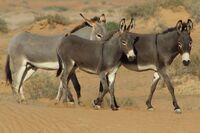Donkey
 From Conservapedia
From Conservapedia | Donkey | |
|---|---|

| |
| Scientific classification | |
| Kingdom Information | |
| Domain | Eukaryota |
| Kingdom | Animalia |
| Subkingdom | Bilateria |
| Branch | Deuterostomia |
| Phylum Information | |
| Phylum | Chordata |
| Sub-phylum | Vertebrata |
| Infraphylum | Gnathostomata |
| Class Information | |
| Superclass | Tetrapoda |
| Class | Mammalia |
| Sub-class | Theriiformes |
| Infra-class | Holotheria |
| Order Information | |
| Superorder | Preptotheria |
| Order | Perissodactyla |
| Sub-order | Hippomorpha |
| Family Information | |
| Family | Equidae |
| Genus Information | |
| Genus | Equus |
| Species Information | |
| Species | E. africanus asinus |
| Population statistics | |
The donkey (Equus africanus asinus) is a horse-like animal of the family Equidae, the domesticated form of the African wild ass (Equus africanus). First domesticated in the Nile Valley around 5000 B.C., they were among the first animals used as a beast of burden, a transport animal and an agricultural tool in the service of man to modern times. The donkey allowed the development of trade and the expansion of civilization over large areas, expanding from the Middle East to the Mediterranean basin to Europe, then to the Americas, performing at a lower cost the same functions as the horse.
Contents
- 1 Description
- 2 Range and habitat of feral animals
- 3 Symbol of stupidity
- 4 References
Description[edit]
The donkey is similar in general build and appearance to the horse, but smaller and more robust, and with longer ears. They are 31 to 63 inches tall, and weigh from 180 to 1,060 pounds, with the size differences depending on the specific breed. The coat varies according to the breed but is generally gray to brownish-gray in color with white on the belly, the muzzle and around the eyes. Several breeds are predominantly black or brownish. A distinctive marking on most breeds is a black stripe down the length of the spine, and a single stripe on either side from the shoulder blades to the elbow.
In addition to the purely external differences to horses, donkeys have some peculiarities that are not recognizable at first glance. In contrast to horses, donkeys have five instead of six lumbar vertebrae, 31 pairs of chromosomes instead of 32, and a slightly lower body temperature, averaging 98.6° F instead of the usual 99.5 to 100.76° F in horses. The gestation period is also longer for donkeys, about 365 to 370 days compared to 330 days for horses. There are also significant differences in behavior: horses tend to flee in stressful situations, while donkeys tend to pause. Donkey mares often live alone with their foals in the mountains and an immediate escape is therefore not always possible without endangering the foal. Donkeys often stop dead in their tracks. Additional stress, for example from blows or screams, tends to increase this rigidity, which has lead, rather wrongfully, to the donkey's reputation as a particularly stubborn or stupid animal.
Range and habitat of feral animals[edit]
Feral donkeys are those animals which have escaped captivity and have thrived in the wild, especially in semi-arid and arid environments, and are found in many regions of the world. Approximately 1.5 million feral donkeys roam the interior of Australia, and another 6,000 animals live in the southwestern United States. These "burros" as they are called (after the Spanish word for "donkey") are protected as a historical symbol; however, a call has been made to cull their numbers[1][2] as they have been said to compete for food and water with domestic range cattle and native bighorn sheep[3].
Symbol of stupidity[edit]
Due to its stubborn nature both real and imagined, the donkey has become a symbol of stupidity; indeed, the word "jackass", the name for the male donkey (the female is "hinney") has become a pejorative for a person acting or thinking in stupid manner. In the Italian novel Pinocchio[4] and the 1940 Walt Disney animated film derived from it, the donkey has been set as one such example, as the author had a character named "Candlewick" convince other boys to come with him to a place of lazy idleness, to do whatever they wanted to do, and then finding out later it was a trap set by evil men who had most of the boys changed into donkeys and sold off.
In the United States, the donkey has become symbol of the Democrat Party. In 1828 the presidential candidate Andrew Jackson was defamed as a donkey by his opponents; he in turn was elected the seventh US president, having made the donkey the symbol of his campaign. In 1871 cartoonist Thomas Nast created political drawings which helped to take down the corruption of New York City boss, William Marcy Tweed. His "Tammany Tiger", named for the hall from which the Democrat Party controlled the city's finances, had an immediate effect; this in turn led Nast to resurrect the donkey and make it the symbol as a whole for the Democrats - associating it with stubborn stupidity literally overnight[5] - and in contrast to the bull elephant he created for the Republican Party.
References[edit]
- ↑ https://www.usatoday.com/story/news/politics/2017/07/19/culling-wcongressional-panel-permits-culling-wild-horses/492056001/
- ↑ https://www.humanesociety.org/news/wild-horses-step-backward
- ↑ https://www.nps.gov/deva/learn/nature/invasive-burros.htm
- ↑ https://www.gutenberg.org/files/500/500-h/500-h.htm
- ↑ https://www.smithsonianmag.com/arts-culture/political-animals-republican-elephants-and-democratic-donkeys-89241754/
Categories: [Mammals] [Equids] [Odd-Toed Ungulates] [Livestock]
↧ Download as ZWI file | Last modified: 03/05/2023 22:18:05 | 45 views
☰ Source: https://www.conservapedia.com/Donkey | License: CC BY-SA 3.0
 ZWI signed:
ZWI signed: KSF
KSF